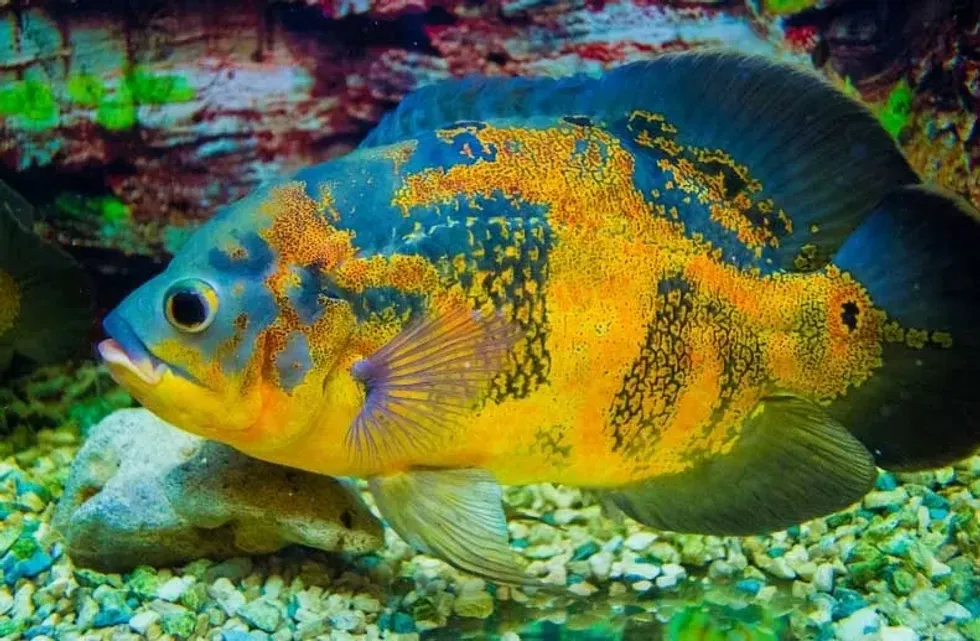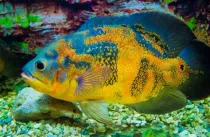Fun Oscar Fish Facts For Kids

Content
- What type of animal is an Oscar fish?
- What class of animal does an Oscar fish belong to?
- How many Oscar fishes are there in the world?
- Where does an Oscar fish live?
- What is an Oscar fish's habitat?
- Who do Oscar fish live with?
- How long does an Oscar fish live?
- How do they reproduce?
- What is their conservation status?
- What do Oscar fish look like?
- How cute are they?
- How do they communicate?
- How big is an Oscar fish?
- How fast can an Oscar fish swim?
- How much does an Oscar fish weigh?
- What are the male and female names of the species?
- What would you call a baby Oscar fish?
- Do humans eat them?
- Are they dangerous?
- Would they make a good pet?
- Did you know...
- Do Oscar fish get lonely?
- Why do Oscars vibrate their tails?
The scientific name of Oscar fishes is Astronotus ocellatus and they are native to South America. In the wild, Oscar fishes are found in freshwater river basins, including the Amazon River basin.
However, they are more popularly kept in aquariums. They are one of the most well-known members of the cichlid family.
In the wild, these fishes often have a darker color, and they prefer to live in shallow water. However, selective breeding for the pet market has given rise to different colors of the cichlid species such as red, orange, yellow, and even albino.
Oscar fishes are fussy about the temperature of the water, and they do prefer warmer conditions. Any temperature conditions below 55.22 °F (12.9 °C) can be detrimental to these fishes. Their diet mainly consists of insects, shrimps, and small fishes that they hunt from the bottom of the river bed.
When kept as a pet they should be given high-quality fish food so that they can maintain their health. One personality trait of these fishes is their aggressive behavior.
Oscar fishes are often quite territorial, and they tend to get aggressive towards other tank mates when kept together. In their native countries, Oscar fishes are also known as a delicacy food for humans.
Keep on reading to know more about these lovely and smart fishes. Also, check out the articles on the piranha fish and guppy to learn more about fishes.
Oscar Fish Interesting Facts
What type of animal is an Oscar fish?
An Oscar fish (Astronotus ocellatus) is a type of fish that is native to the rivers of South America, but they are also widely popular as an aquarium species.
What class of animal does an Oscar fish belong to?
Oscar fishes (Astronotus ocellatus) belong to the class actinopterygii, which is a class that is closely related to stingrays. They are also from the family cichlidae.
How many Oscar fishes are there in the world?
The exact population of Oscar fish is yet to be studied, and therefore not known.
Where does an Oscar fish live?
Oscar fishes hail from the rivers of South America. They prefer to live in shallow waters of river basins.
When it comes to their geographical range, Oscar fishes are found in the freshwater, or white-water, areas of Argentina, Paraguay, Peru, Uruguay, Brazil, Colombia, and Venezuela. They have even been spotted in New Guinea and Suriname.
As a popular breed of aquarium fish, Oscar fishes are also widely found in the USA, UK, India, China, and other Asian countries. In Florida, Oscar fishes have been used as game fish in hunting.
What is an Oscar fish's habitat?
Oscar fishes like to live in shallow water and warm places. They cannot tolerate extreme cold water, and they prefer a temperate climate.
The optimal habitat of an Oscar fish has a temperature between 71-77 °F (22-25 °C ). Oscar fishes prefer to live in areas with sandy surfaces, this is because they mainly feed by searching the bottom of river beds.
Who do Oscar fish live with?
In their wild habitat, an Oscar fish will most likely live with their school. If you keep them in an aquarium, make sure to give them an ample amount of space.
Oscars are known for being a territorial fish species, which can quickly turn into a fight with their tank mates if they are in an aquarium. It is important to maintain a large tank size when keeping Oscar fish, so that they don't antagonise the other fishes.
How long does an Oscar fish live?
Not much is known about the lifespan of Oscars in the wild. However, in aquariums, they can live up to around eight to ten years old. Some have even lived to be 20 years old, but that is extremely rare.
How do they reproduce?
Oscars tend to mate in monogamous pairs. It takes between 12 and 14 months for an Oscar fish to reach sexual maturity.
It has been noted that male Oscars develop much differently compared to female Oscars. The sex of the fishes can be determined by looking at their breeding tubes, because the breeding tubes of female Oscars are flat, while the breeding tubes of male Oscars are pointed.
As the tubes appear in the fishes, spawning takes place within 48 hours. Male Oscars may even participate in lockjaw to claim their territory or mate.
One interesting thing about Oscar fish is that their color intensifies during breeding. Both male and female Oscar fishes can spend days or weeks clearing up rock crevices before they are ready to lay their eggs.
The egg-laying process for an Oscar fish can last up to three hours. The number of eggs laid by Oscar fishes usually depends on their size.
A small-sized Oscar fish can lay up to 500 eggs, while a larger Oscar fish may lay up to 3000 eggs. In a single year, a female Oscar fish may produce three to four batches of eggs.
Oscars prefer a temperature of about 77 °F (25 °C) while laying their eggs. The eggs may hatch after a duration of two to three days, and both male and female Oscars take care of the young.
The baby fishes live with their parents till they reach the age of one. Another thing to note is that Oscars usually mate during the rainy season.
If you want to breed Oscars in your aquarium, you should maintain all the breeding patterns followed by wild Oscars. Try to keep the breeding pair of Oscar fishes in a separate tank from their usual tank mates.
Include an ample amount of rocks in the tank along with their usual sand substrate. Adding live plants also helps to make the tank look and feel more like their native river basins.
To reduce all possibilities of aggressive behavior, try to find a pair that has already bonded. Do not forget to install egg-safe filters in your tank if you are going to attempt breeding these cichlids.
What is their conservation status?
Oscar fishes have the conservation status of Not Listed.
Oscar Fish Fun Facts
What do Oscar fish look like?
Oscar fishes can grow to be quite big. One of the best things about Oscar fishes has to be their color.
Wild Oscars are said to have darker coloring, with a variation of dark green, gray, black, and brown. However, selective breeding of the South American Oscar fish has given rise to various other colors within the pet market.
The different types of Oscar fish include tiger Oscars, albino Oscars and red Oscars among many other varieties. Red or orange markings are quite common on the sides of an Oscar fish.
Upon a closer inspection of these fishes, you will find ocellis, or rings, near their dorsal fin. Scientists think that cichlids use these rings to ward off predators, since from a distance the ocellis look like the eyes of cichlids.
Another notable thing about Oscars is their fins fan-like shape, which often has a faded color at the top. The colors found on juvenile Oscars are different compared to that o adult fishes and juveniles may also have a striped look.
Oscar fish species have also been known for their color-changing qualities, which help them to mix with their environment when they are under threat. Cichlids may develop certain changes when they are bred for the aquarium.
These domesticated fishes, unlike wild Oscar fishes, have longer fins and more color variations. Oscar fishes almost seem like pieces of abstract art because of their beautiful color variations.
Tiger Oscars are one of the most exquisite-looking fishes found in the cichlid family. Tiger Oscars bodies are usually covered in dark brown or black color along with a mix of orange and red.
The fish derives its names from the tiger-like pattern that is seen on its body. Apart from that, tiger Oscars may also look like an erupting volcano. Species with more red scales are frequently known as red tiger Oscar fishes.
Albino Oscar fishes are not completely white, in fact their natural white color is often contrasted with red or orange. Although Albino Oscar fishes aren't extremely rare, they are widely sought-after in the pet market.

How cute are they?
The colorful Oscar fishes lie somewhere between being ugly and cute. They aren't a fish species that tends to make you smile as quickly as goldfishes do, but Oscar fishes will awe you with their beautiful, striking colors.
How do they communicate?
Like other fishes, Oscar fishes also communicate with the help of low-frequency sounds. They are also very smart creatures. These low-frequency sounds are mostly in the form of pulses and grunts, which humans probably wouldn't be able to detect.
They also use visual or vocal ways of communicating with their family members or tank mates. An interesting fact about freshwater Oscar fishes is that their eyes become darker if they lose a fight with another fish. This is often a sign of them becoming aggressive, or of their disappointment.
How big is an Oscar fish?
The usual size of an Oscar fish is between 11.8-18 in (30-45 cm). They can grow to be quite big, so a small tank doesn't usually work for this South American fish species.
Oscar fishes are slightly bigger than goldfish who can grow to be 14 in (36 cm) when left in the wild. However, in an aquarium setting, goldfish may only reach a size of 6 in (15 cm). Oscar fishes grow to their full size whether in an aquarium or the wild.
How fast can an Oscar fish swim?
No exact data can be found about the swimming speed of Oscar fishes. However, according to the MIT technology review, some fishes can reach a swimming speed of 70 mph (112 kmph). But, there are doubts in regards to whether Oscar fishes have the ability to swim that fast, as this species is fairly lazy and often remain sedentary.
How much does an Oscar fish weigh?
The average weight of the Oscar fishes is around 3.5 lb (1.6 kg). They may look like small fishes in their pictures, but these fishes can grow to be quite big.
Because of their size, it is important to give them bountiful space in their tank. If you are planning to get two Oscar fishes, then you have to buy an aquarium with the capacity of 75-85 gallons (340-386 l).
What are the male and female names of the species?
There are no specific names for males and females of the Oscar fish species.
What would you call a baby Oscar fish?
Baby Oscar fishes are known as fry or juveniles like all other fish species.
Do humans eat them?
Yes, humans do eat Oscar fishes. They are especially popular in their native South American countries.
Though Oscar fishes have mostly been known as an aquarium species, many people also love to eat this fish. Because the fish reaches a good size, the species has been popularly bred to become natural food sources for local people.
However, you shouldn't pick out Oscar fishes from your tank to feast on, as the ornamental aquarium species may be a tad different from Oscar fishes found in their natural habitat.
Are they dangerous?
Oscar fishes are definitely not dangerous in regards to human life. People have handled this species for a long time, and Oscar fishes are also used as a food source for humans.
Their tiny teeth aren't able to penetrate the human skin, meaning they can't bite or cause any damage to humans. But, one negative characteristic of the cichlid Oscar fish is their aggressive behavior.
Even in their natural habitat, Oscar fishes are all about showing their aggressive nature, mostly in an attempt to mark their territories.
They will often get into fights with their tank mates which can result in injuries for the other fishes. This is why a bigger tank size is recommended, so that each fish has enough space to swim and use as their own.
Would they make a good pet?
Yes, Oscar fishes make good pets, and they have been popular in the pet market for a very long time. The fish has been transported from their native countries to places like China and India, where they have almost turned into an invasive species.
Oscar fishes are also common pets in the UK and USA as people enjoy their bright and beautiful colors.
Albino Oscar fishes are a favorite of many people because of their exceptional look.
The price of an Oscar fish can vary between 8 USD and 100 USD, and this price mostly depends on their color. However, when buying a pet you should keep in mind that there are costs other than just the initial price for the animal itself.
Owners will need to arrange for a tank or aquarium that can hold many gallons of water. The water should be fresh, and it should be changed regularly in order to keep the fishes healthy.
The tank should feel natural to the fish, so it is always better to have sand substrate at the bottom along with lots of rocks and live plants for the Oscar fishes to hide.
It is wise for owners to invest in a good quality filter along with a thermostat, as the temperature conditions are very important for Oscar fishes.
Try to maintain the temperature between 71-77 °F (22-25 °C) as this is ideal for the fishes. The water in the tank should have a neutral pH level, and the amount of chlorine should be minimal.
It is also important to pay attention to the diet of the Oscar fishes as they need to have a balanced diet.
As a bottom-feeding fish, you will often find your Oscars lurking at the base of the tank, so you may want to place their food at the bottom of the tank to mimic their natural way of eating.
The diet of an Oscar fish includes shrimps, small fishes, crustaceans, insects, and detritus.
Pet owners may want to incorporate good quality fish food into their diet.
You may even feed your fishes bloodworms or brine shrimps from time to time. It is advised to remain calm when giving Oscars their food as they have a tendency of behaving aggressively while eating.
If owners take proper care of the tank and Oscar fishes, then these beautiful fishes can be kept quite happily and easily. It may take owners a little time to pick up the cues for the perfect tank conditions, but proper practice and time yields the best results.
Did you know...
Even though Oscar fishes feed through a suction motion, they have teeth that help them to keep a better grip on their food while eating. But, these teeth are relatively small and harmless. They are known for using their jaws to put pressure on their food before gulping it down.
If you want to keep other fishes in the tank along with your Oscar fish think about including species like catfishes, silver dollar fish, convict cichlids, firemouth cichlids, and blue acara. It may be tempting to add bigger cichlids, but they can end up in aggressive tank fights with the Oscar fish.
It is also advisable to avoid small fishes that the Oscars can eat.
Do Oscar fish get lonely?
A good thing about Oscar fishes is that they can easily survive alone. So, owners do not need to add tank mates with them, as solitary life is fine for this species.
However, if you want to breed the Oscar fish, it is always better to get a pre-bonded pair and give the fishes ample water to play around with and grow.
Why do Oscars vibrate their tails?
Oscar fishes are known for vibrating their tails as a part of their courting ritual. Aside from vibrating their tails, Oscar fishes also engage in lip-locking. However, at times the shivering or vibration may be caused by underlying problems. If your fish is alone in the water, it may need special attention.
Here at Kidadl, we have carefully created lots of interesting family-friendly animal facts for everyone to discover! Learn more about some other fish including blobfish, or angelfish.
You can even occupy yourself at home by drawing one of our Oscar Fish coloring pages.
We Want Your Photos!
More for You
See All
Bachelor of Arts specializing in Journalism and Mass Communication, Postgraduate Diploma in Sports Management

Moumita DuttaBachelor of Arts specializing in Journalism and Mass Communication, Postgraduate Diploma in Sports Management
A content writer and editor with a passion for sports, Moumita has honed her skills in producing compelling match reports and stories about sporting heroes. She holds a degree in Journalism and Mass Communication from the Indian Institute of Social Welfare and Business Management, Calcutta University, alongside a postgraduate diploma in Sports Management.
Bachelor of Law

Abdulqudus MojeedBachelor of Law
A versatile professional with a passion for creative writing and technology. Abdulqudus is currently pursuing his Bachelor of Law from the University of Lagos and has experience as a tutor, intern assistant, and volunteer. He possesses strong organizational skills and is a detail-oriented person.
Disclaimer
1) Kidadl is independent and to make our service free to you the reader we are supported by advertising. We hope you love our recommendations for products and services! What we suggest is selected independently by the Kidadl team. If you purchase using the Buy Now button we may earn a small commission. This does not influence our choices. Prices are correct and items are available at the time the article was published but we cannot guarantee that on the time of reading. Please note that Kidadl is a participant in the Amazon Services LLC Associates Program, an affiliate advertising program designed to provide a means for sites to earn advertising fees by advertising and linking to Amazon. We also link to other websites, but are not responsible for their content.
2) At Kidadl, we strive to recommend the very best activities and events. We will always aim to give you accurate information at the date of publication - however, information does change, so it’s important you do your own research, double-check and make the decision that is right for your family. We recognise that not all activities and ideas are appropriate for all children and families or in all circumstances. Our recommended activities are based on age but these are a guide. We recommend that these ideas are used as inspiration, that ideas are undertaken with appropriate adult supervision, and that each adult uses their own discretion and knowledge of their children to consider the safety and suitability. Kidadl cannot accept liability for the execution of these ideas, and parental supervision is advised at all times, as safety is paramount. Anyone using the information provided by Kidadl does so at their own risk and we can not accept liability if things go wrong.
3) Because we are an educational resource, we have quotes and facts about a range of historical and modern figures. We do not endorse the actions of or rhetoric of all the people included in these collections, but we think they are important for growing minds to learn about under the guidance of parents or guardians.







